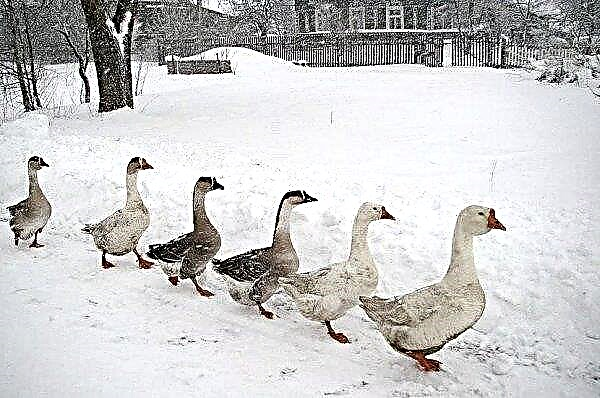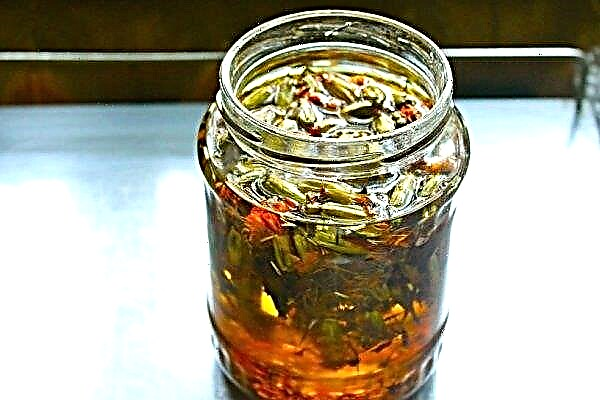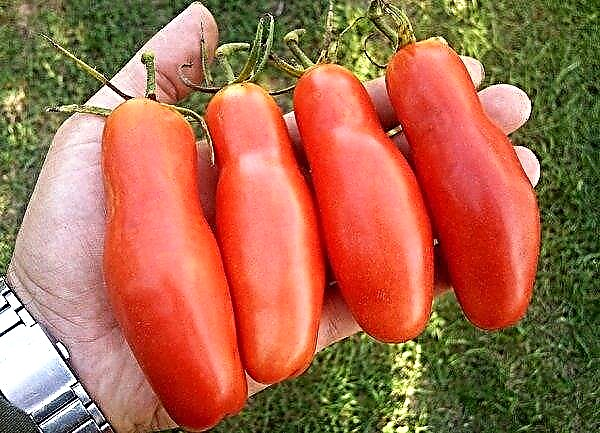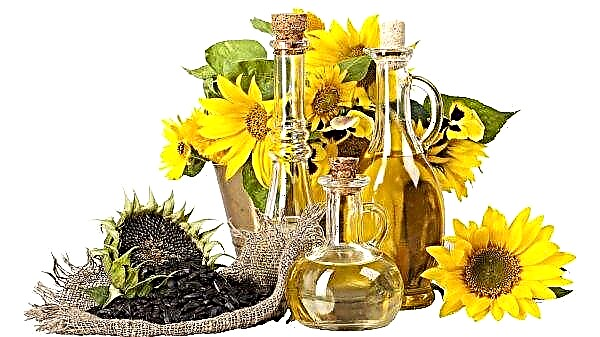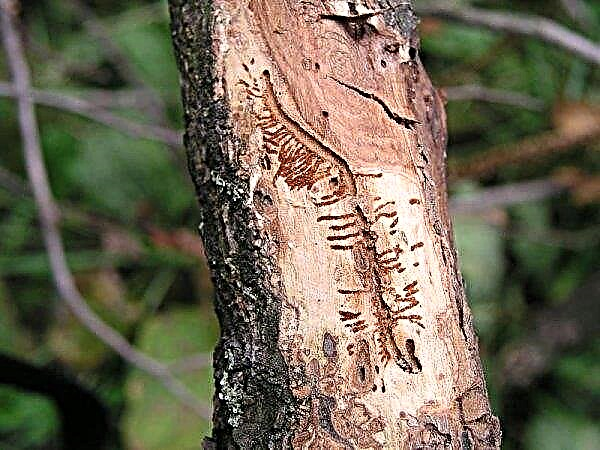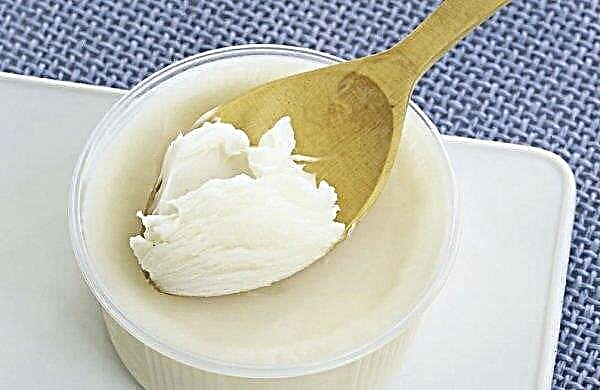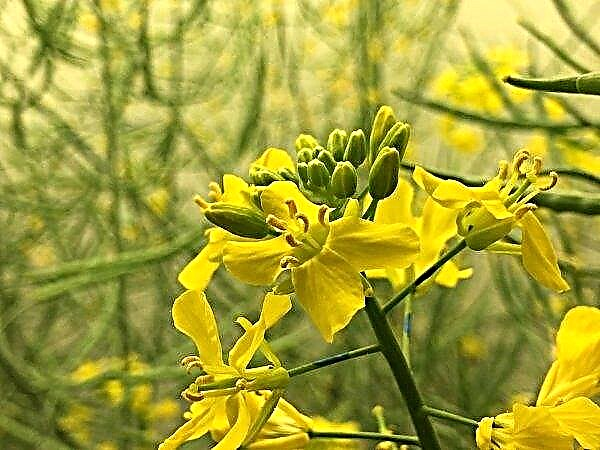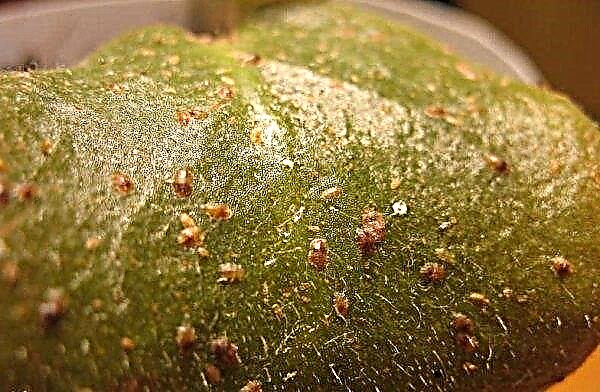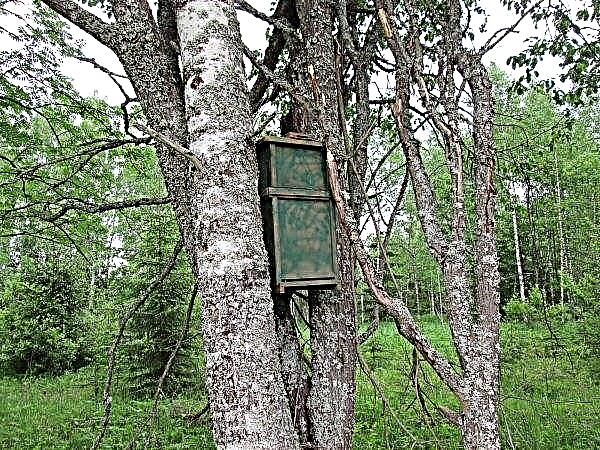There are many varieties of tomatoes that have not only different tastes, but also color and shape. One of the most unusual varieties with an abundance of colors is considered the Japanese Truffle tomato.
Grade description
This variety appeared quite recently and has not yet gained popularity among farmers and tomato lovers. He was taken out by breeders from Russia in 2001.
Did you know? This tomato got its name because of the similarity of form with an elite mushroom.
"Japanese Truffle" is famous for its oblong shape, as well as an abundance of varieties. Consider the descriptions and types of this variety below.
Characteristics of Japanese Truffle Tomatoes:
- Medium early ripening tomato. Fruits appear on the 110-120th day after seed germination.
- The variety is an indeterminate type. This means that the main stem can grow continuously.
- The height of the bush reaches 1.5–2 m, depending on the soil in which the plant is planted.
- Due to the high growth of the tomato, it must be tied up and often stepsoned.
- The stem of a tomato is powerful.
- The leaves are medium sized, green in color.
- Pear-shaped tomato, ribbed.
- The peel of the fruit is dense, does not crack, making vegetables convenient to transport.
- Productivity is low, from the bush you can collect 3-4 kg of tomatoes.
- 5-6 fruits ripen on 1 brush.
- The weight of 1 vegetable is about 200 g.
- The tomato forms 1 stalk, on which from 4 to 6 brushes are placed. The remaining brushes are recommended to be cut off, because they are empty and do not bear fruit.
- The variety is suitable for various types of preservation, however, tomato juice is not made from it.
- The agricultural technology of growing these tomatoes can be carried out both in open and in closed soil.
There are several varieties of Japanese Truffle tomatoes. According to their characteristics, they do not differ, their only differences are the color of the fruits and the taste of the flesh.
Varieties of Japanese Truffle Tomatoes:
- "Red Truffle" - red color, in which there are inclusions of a brownish tint. To taste, the fruits of this variety are sweet, with a slight acidity. This is a subspecies of tomatoes canned.
- "Orange Truffle" - a clear difference from the "Red" is not only the color, but also the early ripening period. The color of the tomatoes is brilliant and saturated. The taste of the fruit felt fruity notes.
- Black Truffle - has a dark brown color with a touch of black. The fruit has many vitamins, it is the most suitable vegetable for consumption during rehabilitation after complex diseases.
- Yellow Truffle - It is painted in a juicy yellow color, it is an example of a hypoallergenic tomato, therefore it is used in the production of baby food.
- "Pink Truffle" - in all tastes similar to “Red Truffle”. The only difference between the two species is the color of the fruit.





The main and important components of this tomato are fiber, vitamins of groups A and C, as well as the pigment lycopene, which fights against diseases of the cardiovascular system.
Did you know? A tomato - low-calorie product, one fruit contains about 22 kilocalories.
Advantages and disadvantages
Before choosing this tomato variety for cultivation, you need to familiarize yourself with its advantages and disadvantages.
- Pros:
- resistance to diseases;
- high taste;
- an abundance of healthy vitamins;
- Some of the varieties are suitable for baby food.
- Minuses:
- the thermophilicity of the bush, the need for its insulation;
- you need to often pinch and tie the plant;
- should be fertilized with high-quality top dressing for good growth.
Features of growing varieties
To obtain a good and high-quality product, the cultivation conditions of this variety must be observed.
It is important to consider the following recommendations for the content of tomatoes:
- choose the right time for sowing seeds;
- observe the technology of the process of sowing seeds;
- water the seedlings;
- fertilize the soil for planting a bush;
- transplant seedlings in time on time.

Optimal conditions
Tomatoes are very fond of light and warmth. Seeds can germinate at a temperature of 14 ° C, but for the subsequent development of the plant, it is necessary to gradually increase the temperature. At a temperature of 20 ° C, tomatoes begin to develop rapidly.
If the plant is in the greenhouse, it is necessary to control the growth of the seedling and prevent overgrowing. To do this, on the contrary, it is necessary to lower the temperature to 14 ° C. Using this method, you can form a good root system.
Important! At a temperature of 10 ° C, plant growth stops.
You can not exceed or lower the temperature - the optimum temperature for growing tomatoes is 20 ° C during the day, and at least 16 ° C at night.
The humidity in the room where the tomatoes grow should not exceed 60%.
Tomatoes do not require special lighting conditions for the development of the root system and fruiting. However, they grow significantly better if you increase the duration of daylight hours. This can be done using artificial lighting (lamps), or arrange the plant in the southern part of the summer cottage.
Sowing seeds
Before sowing seeds, they must be sorted and processed. Already processed seeds are sold in specialized gardening stores, but if you pick them from the fruit yourself, you must follow the recommendations for preparing for sowing. Processing takes place in several stages:
Processing takes place in several stages:
- Seed selection. Seeds should be defect-free, dry, of uniform color and structure. If low-quality seeds are used for sowing, seedlings may not sprout.
- Growth stimulant treatment. This process increases the growth of the tomato bush and improves the quality of the resulting product. You can use chemicals - "Kornevin", "Epin", "Zircon", or alternative - tincture of aloe, honey decoction.
- Seed disinfection. To protect the seeds from diseases and parasites, it is necessary to carry out the disinfection process in advance. For this, the seeds are kept in a solution of potassium permanganate for 20 minutes, after which they stand for 1 day in warm water.
For sowing tomatoes "Japanese Truffle" you can use both purchased land, and independently prepared.
In a home environment, the soil is mixed in this way:
- they dig up the earth from the garden and dry it;
- the following components are mixed: turfy earth, sifted sand and humus;
- add phosphates as fertilizer.
- mixed earth is steamed in a water bath for about 2 hours.
To indeterminate varieties of tomatoes also include such as:
When the soil mixture is ready, you can plant seeds in it.
Sowing technology:
- prepare a container for seedlings: pot, container, box;
- place drainage in the form of pebbles or pebbles in the tank;
- then pour the soil on 2/3, tamp tightly;
- water the soil;
- make 2 cm indentations;
- lay the seeds in the recesses and sprinkle them with a loose layer of soil;
- water the soil again;
- close the crops with a film
- Move the container to a warm room.
Seedling Care
After sowing seeds and the formation of seedlings, dives of sprouts are made. This procedure is necessary to separate the formed plants from each other. The dive process takes place in this way:
The dive process takes place in this way:
- it is necessary to start the procedure when the first 2 leaves appear on the sprout, approximately on the 10-14th day after sowing the seeds;
- a couple of days before a dive, the bush is stopped watered;
- near the base of the stem carefully put a teaspoon in the ground;
- Using a spoon, carefully remove the seedling along with the root and ground;
- in a separate container, a recess is made in which a sprout is then placed;
- Then they compact the soil near the seedling and water it with a small amount of water.
Planting seedlings in open ground
The best period for transplanting tomatoes to the garden is considered spring and summer. Planting must be carried out before the first flowering, that is, before the beginning of June. 7 days before the established day of transplanting seedlings, the soil is abundantly fertilized with mineral substances.
Important! The seedling age for planting should be at least 2.5 months.
Technology of transplanting tomato "Japanese Truffle" into the open soil:
- a couple of days before transplanting, it is necessary to dig up the soil, remove excess roots and weeds;
- before transplanting, pour a layer of humus into the soil;
- water the earth with plenty of water;
- dig beds 20-25 cm apart;
- dig holes in beds 15 cm deep;
- water the seedlings before they are taken out of the seedling tank;
- pull the tomato out of the container without damaging the root system;
- plant a bush in a hole, placing it in the center;
- pour soil on the seedling, slightly applying it;
- pour warm water on the sprout.

Care Features
In order for the tomato bush to give a plentiful harvest and to please a long period of growth, it is important to care for the plant based on the requirements of this variety.
The criteria for leaving include:
- watering;
- fertilizer;
- loosening the soil;
- bush formation.
Watering and feeding
Watered "Japanese Truffle" once every few days. The bush does not need abundant hydration, but watering is necessary regularly. Water for irrigation is used at room temperature. The best time of day to moisten the soil is the time after sunset.
As fertilizers, combined dressings are used, which must necessarily include potassium and phosphates. Substances in the form of a solution are applied to the leaves and stem of a plant with a spray gun. You can also use natural top dressing - wood ash.
Soil cultivation and weeding
Loosening the soil is an important element of plant care. It prevents the appearance of a crust on the soil. It is necessary to carefully loosen the ground with a hoe near the bush, without touching the roots of the tomato.
Important! Sometimes the procedure of loosening is called “dry watering”, since when properly performed, the tomato does not need water for up to 10 days.
It is equally important to weed the ground near the tomato. Remove weeds and excess shoots near the bush, as well as cut dried leaves and stems as they appear. This will allow the tomato to get more trace elements from the soil.
Shrub formation and pinching
Pasynkovka - a necessary and mandatory procedure for the "Japanese Truffle". Since the branches of the tomato bush grow at an accelerated pace, gardeners cut them with a sharp garden knife, leaving no more than 2-3 stems. The trunk is formed of 5-6 brushes.
Remove stepchildren and side branches immediately after they appear. Thus, you will allow the plant to receive more nutrients that will be spent on the growth of the fruit, and not on the growth of branches.
The fruits of this tomato variety are quite heavy, so it is necessary to make a garter of the bush so that the stem does not bend from gravity. To do this, use a rigid support, to which the stem is tied. In addition, brushes with fruits should also be tied.
Diseases and Pests
Despite the resistance to the most famous diseases of tomatoes, the Japanese Truffle is susceptible to certain diseases with improper care of the bush.
The disease is a black leg - the most common ailment in solanaceae of this variety. It is expressed in the blackening of the stem at its base. As a fight against the black leg, watering is carried out with a solution of potassium permanganate in a proportion of 1 g / 10 l of water.
Also helps the specialized drug "Bison", which effectively destroys the darkening of the trunk. During the period of top dressing with disinfecting preparations, it is necessary to reduce the number of irrigations and improve ventilation, especially for greenhouse bushes.
Damage to tomato with phomosis is possible. It appears in the form of brown spots on the leaves, in which small particles of black mushrooms are clearly visible. To destroy the infection, fungicides are used, and they also remove plaque on the leaves. As in the previous case, it is necessary to reduce soil moisture and exclude fertilizing with nitrogen fertilizers. Sometimes dry spots appear on tomato leaves. This is also a sign of plant disease. Spots of a round shape grow from 2 mm to a couple of centimeters in diameter. Leaves affected by such spots dry out and fall off. To eliminate this problem, you need to use horticultural medicines "Concento" and "Antracol".
Sometimes dry spots appear on tomato leaves. This is also a sign of plant disease. Spots of a round shape grow from 2 mm to a couple of centimeters in diameter. Leaves affected by such spots dry out and fall off. To eliminate this problem, you need to use horticultural medicines "Concento" and "Antracol".
In addition to diseases, dryness and decay, parasitic insects can attack the plant.
Tomatoes are susceptible to the attacks of the following pests:
- spider mite;
- aphid;
- thrips;
- whitefly.
You can free the bush from parasites using insecticides. A subsequent treatment with fungicides will consolidate the result.
Important! The Japanese Truffle variety is generally resistant to harmful microorganisms and fungal diseases.
Harvesting and storage
Approximately 115–120 days elapse from planting to harvesting. Tomatoes are plucked from the bush as the fruits ripen. Storage after harvest is long, as tomatoes have a fairly strong skin. In addition, after a stall from a bush, a tomato can ripen a little more, gradually acquiring a juiciness and a sweet taste.
Storage after harvest is long, as tomatoes have a fairly strong skin. In addition, after a stall from a bush, a tomato can ripen a little more, gradually acquiring a juiciness and a sweet taste.
So, Japanese Truffle is a one-of-a-kind tomato variety. Its resistance to many diseases, spectacular appearance and spicy, pronounced taste will appeal to any gardener. Growing these tomatoes in a garden or in a greenhouse, you will get vegetables that are unique in taste for various culinary purposes.


